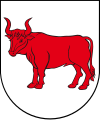 Alternate names: Bielsk Podlaski [Pol], Byelsk [Yid], Bielsk, Bilsk, Bielsko Podlaskie, Byelsk Podlaski, Bielsk-Podliask, Russian: Бельск-Подляски. ביעלסק-Yiddish. 52°46' N, 23°12' E, 25 miles S of Białystok, 68 miles SSW of Hrodna (Grodno), in Bielsk County, Podlaskie Voivodeship, NE Poland. 1900 Jewish population: 3,968.
Alternate names: Bielsk Podlaski [Pol], Byelsk [Yid], Bielsk, Bilsk, Bielsko Podlaskie, Byelsk Podlaski, Bielsk-Podliask, Russian: Бельск-Подляски. ביעלסק-Yiddish. 52°46' N, 23°12' E, 25 miles S of Białystok, 68 miles SSW of Hrodna (Grodno), in Bielsk County, Podlaskie Voivodeship, NE Poland. 1900 Jewish population: 3,968.
Yizkors: Bielsk-Podlaski; sefer yizkor... (Tel Aviv, 1975); Bóżnice Białostocczyzny (Białystok, 1992); Pinkas ha-kehilot; entsiklopediya shel ha-yishuvim le-min hivasdam ve-ad le-aher shoat milhemet ha-olam ha-sheniya: Poland vol. 8: Vilna, Białystok, Nowogródek districts (Jerusalem, 2005).
ShtetLink. JOWBR burial list: [April 2009]
CEMETERY:
- Jewish Cemetery. 2007 population: 26,577. [April 2009]
- Cemetery photos. [April 2009]
- Town also used cemetery at Bocki in Bielsk District. Pre-WWII towns with Jewish population in 1921 in the district include Annopol, Boratynie Lacki, Borysowszczyzna, Buzyska, Chrolowice, Czarna Wies, Czyze, Czyzyki, Dubiny, Dzaje Wolka, Falki Stare, Glinnik, Grabowiec, Granne, Grodzisk, Holowieski, Holynka, Hornowo, Kalejczyce, Kalnica, Krasna Wies, Kruszyniany, Makaraki, Malesze, Nadbuzna, Nurzec Stacja, Odrynki, Osbizki, Paszkowszczyznie, Pobikry, Polsze, Przybyszyn, Radzilowka, Rogacze, Rudka, Sasiny Ostrow, Sieniewice, Sobiatyn, Stary Kornin, Swirydy, Szczyty, Tolowin, Wierzchnicz, Zery Czubiki, Zurobice.
- Directions, photos, and description:. "The entrance side is marked by a simple sign and a worn chain link fence (Image 1,2). Immediately inside are a number of memorials and a long rectangular concrete structure (Images 3,4). The western side drops off VERY steeply, beneath which is a dump, with the land eroding (Image 5). A worn path skirts along this edge. Three memorials are preserved, 4 simple matzevoth (with 3 in Hebrew cursive script) and 100+ supports are in situ (Images 6,7). The greatest threat appears to erosion on the western side from expansion of the dump." [April 2009]
- Burial list and gravwestone photos. [August 2014]
- Burial list [Jan 2015]
US Commission No. POCE000101
The cemetery is located in W part of town before the filling station on road to Bransk. 1993 town population: 26,286 with 1 Jew.
- Town: 1. Urzad Miejski [Municipal Office] Bielsk Podl., Kopernika 1, Burmistrz tel. 23-88, Archiwum, Rautsz, tel. 22-44.
- Regional: Wojewodzki Konserwator Zabytkow Bialystok, Dojlidy Frabryczne 23, tel. 41-23-32.
- Interested: Henyrk Kosieradzki, Bielsk Podl., Swierkowa 7, tel. 25-24 and Muzeum Okregowe, Ratusz, Biesk Podlaski; tel. 22-24.
The earliest known Jewish community was about 1487. 1921 Jewish population was 2,392. Noteworthy historical events: second half of the 16th century expulsion of Jews from Bielsk. Living here were Icchak Cwi Horowic, Efraim Mazi, and Rabbi Mosze Aron Bendas. The Jewish cemetery was established in 1807. Buried in cemetery: Jowel Landau. Last known Jewish burial was about 1941. The Jewish community was Orthodox, Conservative, and Progressive/Reform. Suraz and surrounding villages of Augustowo, Czyze, and Hajnowka, 10 to 25 km. away used this unlandmarked cemetery. The isolated suburban hillside has a sign in Polish. Reached by crossing private property, access is open to all with no wall, fence, or gate. Size of cemetery before WWII was 2.5 to 3.0 hectares; now 1.5 hectares. 20-100 gravestones are in the cemetery, some in original location and less than 25% toppled or broken. The gravestone dates from 1850 to 20th century. The marble, sandstone, and concrete tombstones and memorial markers are rough stones/boulders, flat shaped stones, and double tombstones have Hebrew, Yiddish, and Polish inscriptions. Some have traces of painting on their surfaces. The cemetery contains special memorial monuments to Holocaust victims. The cemetery contains marked mass graves but no known mass graves. [sic] There are no structures within the cemetery. The municipality owns the property, now used for closed Jewish cemetery and waste dump. Properties adjacent are commercial or industrial and residential. The cemetery size is smaller than in 1939 because of commercial or industrial development. Occasionally, private visitors stop. The cemetery was vandalized during WWII and now occasionally. No maintenance or care. Security is a serious threat. Development of a neighboring factory is a very serious threat. Weather erosion, pollution, and vegetation are moderate threats. Vegetation overgrowth is a constant problem, disturbing graves.
Tomasz Wisniewski completed the survey on 7 October 1991. Documentation: "Opracowanie Wlasne Tomasza Wisniewskiego/Maszynopis." Wiesniewski visited the site ten times between 1985 and 1991.
UPDATE: Unreported in the survey to the U.S. Commission for the Preservation of America's Heritage Abroad above, Wisniewski added to the survey above in his book Jewish Bialystok on p. 64-5 that the Jewish community dated from May 30 , 1487 when King Kazimierz Jagiellonczyk "made Jews the lease holders of custom duty in Bielsk." Jews were expelled in 1564 and not officially "allowed to settle again until between 1802 and 1803." The community reconstituted in 1807 under the Orla kahal. 1878 Jewish population was 3,968 out of 5,810 residents. 2,500 Jews lived in Bielsk area between WWI and WWII. The last rabbi was Moshe Aron Bendas. The cemetery on Bransk road just behind the gas station has an obelisk dedicated to Nazi victims that reads "Polish citizens of Jewish nationality"...two tombstones erected by Jewish survivors. [ESR-September 2000]
